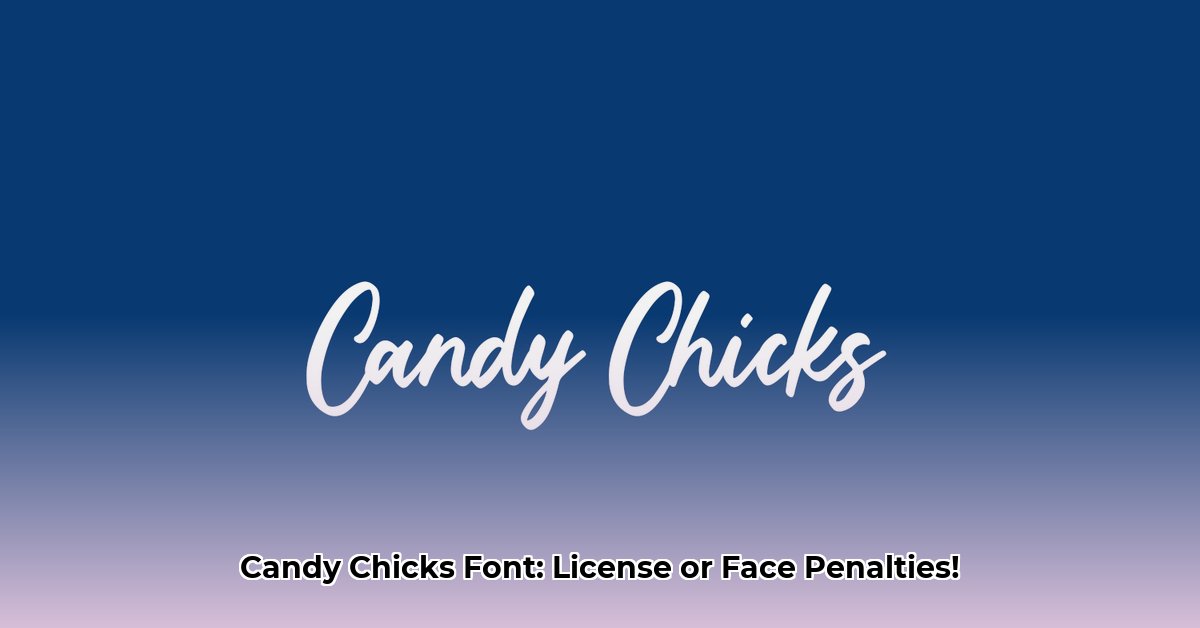
Navigating the free font landscape can be tricky. While “free” is appealing, it doesn't always mean unrestricted use. The Candy Chicks font illustrates this perfectly: a seemingly simple license with potential legal pitfalls. This guide clarifies acceptable usage and helps avoid costly mistakes.
Decoding the Candy Chicks License: Personal vs. Commercial Use
The Candy Chicks font license explicitly permits personal use. This covers projects like birthday cards, personal websites, or family newsletters. However, commercial use is strictly prohibited.
What constitutes commercial use? This is where the complexities arise.
Examples of Prohibited Commercial Use:
- Product Sales: Using Candy Chicks on t-shirts, mugs, or any product sold for profit.
- Marketing Materials: Brochures, business cards, or website banners used for business promotion and revenue generation.
- Client Work: Designing logos or marketing materials for paying clients using Candy Chicks.
- Digital Product Sales: Utilizing the font in templates, ebooks, or other sold digital products.
Examples of Permitted Personal Use:
- Personal Projects: Invitations, family event posters, or personal blog graphics.
- Non-profit Activities: Usage for a non-profit, provided no profit is generated. (Always seek legal confirmation.)
- School Projects: Posters, presentations, or school assignments.
- Non-commercial Blogs/Websites: Personal sites without advertising or sales.
The definition of “commercial use” can be subjective. When in doubt, prioritize caution.
The Potential Price of Non-Compliance: Penalties and Enforcement
The Candy Chicks license mentions potential penalties for unauthorized commercial use, but lacks specifics. Consequences could range from a cease-and-desist letter to a lawsuit, depending on the circumstances and the font creator's legal action. The ambiguity highlights the need for proactive measures.
Enforcement is challenging due to the lack of a defined mechanism. The creator might discover unauthorized use through online searches, website monitoring tools, or user complaints. Jurisdictional ambiguity further complicates matters. This emphasizes the importance of preventative strategies.
Best Practices: Protecting Yourself from Legal Trouble
Font creators and users must take proactive steps to mitigate risk.
For Font Creators:
- Crystal-Clear Licenses: Employ precise language that unambiguously defines permitted and prohibited uses, specifying legal jurisdiction and consequences. Legal counsel is strongly recommended.
- Active Monitoring: Regularly monitor online use of your font using digital tools to detect unauthorized usage. Early detection facilitates quicker intervention.
- Legal Counsel: Essential for crafting legally sound licenses and devising effective enforcement strategies.
For Font Users:
- Meticulous License Review: Thoroughly read the entire license before using the font; don't just skim. Understanding the terms prevents accidental infringement.
- Commercial Font Selection: When using fonts for profit, choose commercially licensed options. This eliminates legal risk.
- Legal Advice (When Needed): Consult a lawyer if the project poses potential commercial use ambiguity. Legal counsel is a cost-effective preventative measure compared to potential lawsuit costs.
- Alternative Font Exploration: Numerous commercially licensed fonts are available, eliminating legal concerns entirely.
Weighing the Risks: A Closer Look
This table summarizes the key risks associated with Candy Chicks font usage:
| Risk Factor | Severity | Likelihood | Impact | Mitigation Strategy |
|---|---|---|---|---|
| Unclear License Terms | High | High | Potential for unintentional infringement, legal action. | Thorough license review, legal clarification. |
| Weak Enforcement Mechanism | High | Moderate | Difficulty detecting and addressing unauthorized usage. | Active monitoring, legal intervention. |
| Ambiguous Legal Jurisdiction | High | Moderate | Uncertainty about applicable rules. | Clearly defined jurisdiction in licenses are essential. |
| Difficulty Proving Infringement | Medium | Low | Proving infringement might be challenging. | Digital watermarking or font embedding techniques. |
The Candy Chicks font exemplifies the risks of free fonts. Understanding the license, proactively mitigating risks, and seeking legal counsel are crucial for avoiding legal issues. Prevention is paramount.
How to Create a Legally Sound Font Licensing Agreement for Commercial Use
Creating or using fonts commercially necessitates a thorough understanding of font licensing. A single mistake can be costly.
Key Takeaways:
- Always read the End-User License Agreement (EULA).
- Understand the difference between personal and commercial use clearly.
- Commercial use usually necessitates a separate, paid license.
- Unauthorized use can result in legal repercussions and financial penalties.
Crafting a Robust Agreement (Step-by-Step):
- Define Scope: Precisely specify granted rights (desktop, web, app, etc.). Ambiguity is unacceptable.
- Permitted Uses: Detail acceptable commercial uses: media types, user numbers, geographical limitations.
- Prohibited Uses: Clearly state forbidden actions (reselling, unauthorized modification, specific contexts).
- Payment Terms: (For paid licenses) Outline payment schedules, currencies, and taxes.
- Copyright Ownership: Explicitly state copyright ownership (usually the font designer).
- Termination Clause: Detail termination conditions and procedures.
- Disclaimers and Liability: Include standard disclaimers limiting liability for consequential damages.
- Jurisdiction and Governing Law: Specify the agreement's governing jurisdiction. Legal counsel is strongly advised.
Commercial vs. Personal Use: The distinction is crucial. Personal use generally involves non-profit projects; commercial use involves creating products or services for sale. When unsure, obtain the necessary license.
Protecting Your Assets: Digital Rights Management (DRM): Implement effective DRM to prevent unauthorized copying and distribution. Techniques range from watermarks to sophisticated software-based protection.
Mitigating Risks (Checklist for Font Users):
- Verify font licenses before use.
- Check for restrictions or limitations.
- Avoid using fonts solely for personal use in commercial projects.
- Choose reputable font providers.
- Consult a legal professional if uncertainty exists.
⭐⭐⭐⭐☆ (4.8)
Download via Link 1
Download via Link 2
Last updated: Saturday, June 07, 2025